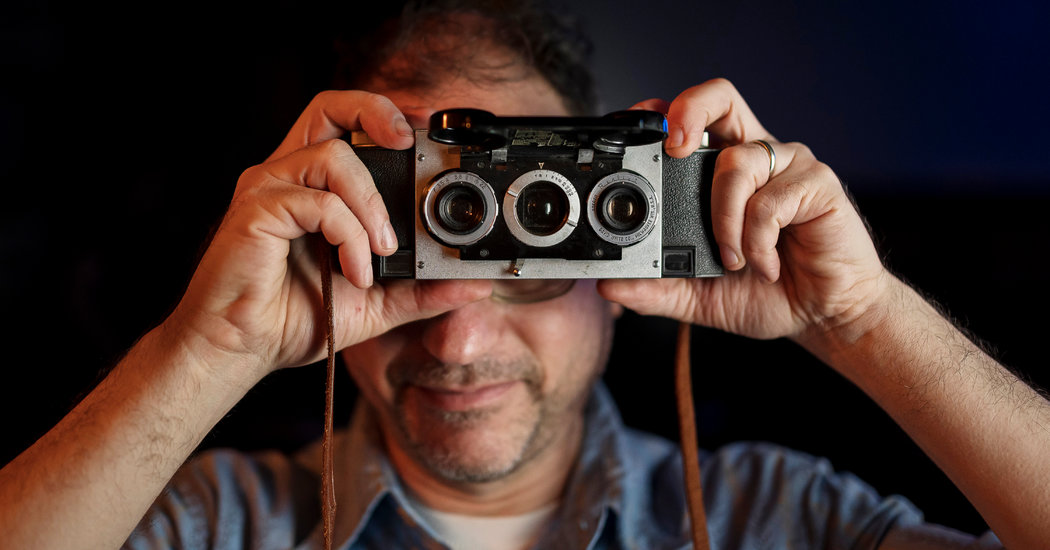
Eric Drysdale opened his silver travel case and, like a magician, unpacked the objects necessary to enter another dimension. Mr. Drysdale was in the Williamsburg section of Brooklyn, in the back room of City Reliquary, a storefront museum devoted to the history of New York’s five boroughs.
He was preparing to host his traveling show, “Midcentury Stereopanorama,” for which the audience, arriving shortly, had paid $15 and been promised the chance to “see the 1950s in Astonishing 3-D!”
An Emmy-winning comedy writer who has worked for “The Daily Show” and “The Colbert Report,” Mr. Drysdale has spent 25 years collecting 3-D photographs along with the antique equipment to make and view them.
He set a camera, several small boxes of Kodachrome slides and a dozen binocular-like viewers on a large table and explained his motivation behind the public viewing.
“I had a feeling that I had something extraordinary, something that people couldn’t or didn’t see,” Mr. Drysdale said. “It was going to waste seen by only me.”
Publishing a book or digitizing the photos and sticking them on the web, he said, wouldn’t fully capture their strange, transporting effect — the way, through 3-D magic, a scene from the past can appear “shockingly present.” He wanted to share the photos in the same way he had experienced them.
In 1994, while cleaning out his wife’s grandmother’s Upper East Side apartment, Mr. Drysdale, 50, found a stereoscopic camera, a 3-D viewer and about 200 images of his wife’s family from the 1940s, including an incredible photo of her great-grandmother — “fresh from the shtetl” — on an outing to a Miami zoo. Five parrots perched on her shoulders and head.
He was amazed by the technological wizardry of 3-D photography but also by its obscurity. He had found the virtual reality of its day, yet no one his own age had ever heard of it.
The technology was introduced commercially in 1947 by the David White Company of Milwaukee, maker of the Stereo Realist camera, which had two lenses, placed about eye-width apart, to replicate the way the human brain sees three-dimensional space.
The camera used slide film, and a special hand-held viewer was required for maximum wow.
The camera’s high cost at the time ($162) kept it out of most American households, Mr. Drysdale said, though 3-D photography caught on with Hollywood stars including Humphrey Bogart and Harold Lloyd. Coffin salesmen were also fans, if the David White newsletter is to be believed (3-D images offered a scale representation of products too big to take on a sales call).
Mr. Drysdale owns about 30,000 images, of which he considers 3,000 or so his “good ones.”
For “Midcentury Stereopanorama,” which he presents for hire in public or in private homes, he has curated a cross-section of American life at mid-20th century, grouped into categories like “Road Trip USA,” “Jewish Celebrations” and “Department Store 1955.”
Given the site for this showing, he sprinkled in more New York content than usual.
When the 12 audience members arrived — Mr. Drysdale’s crowds are limited by his number of viewers — he instructed them to gather around the table while he presented an introductory slide show.
The intimate crowd and the glow of the projector screen created the impression of time-traveling back to a suburban basement rec room, even before Mr. Drysdale finished his history lesson and handed each attendee a box of slides.
One expected to have a quaint experience not unlike looking through a child’s View-Master. But with the press of a button, you were suddenly plunged into another world and almost overwhelmed by visual detail.
In a photo of five boys gathered around a dining table for a birthday party, one boy had a comic book opened, and you could see under the page fold. Another photo had been taken inside a machine shop, and every tool on every workbench — even the metal chain hanging from a bare ceiling light bulb — stood out with amazing, reach-out-and-touch-this clarity.
Ida Kreutzer, a professional photographer, was so captivated by one image that she took out her iPhone at one point and tried to capture it through the viewer. Asked later, Ms. Kreutzer said it was a photo of two women in water, one of them sitting on a diving board. Written on the diving board were the words: “No dreams.”
“It invited a whole bunch of questions to be asked that will never be answered,” she said.
The hyper-reality of these dreamy visual landscapes created sadness in some of the attendees after awhile.
“Especially because a lot of those worlds don’t exist anymore,” said David Frackman, a computer programmer who wrote a master’s thesis on projected 3-D environments and was curious about stereoscopy. “I realized, ‘Oh, all of these people are probably dead.’”
Still, Mr. Frackman said he enjoyed seeing an America filled with home bars, beauty queens and bustling department stores, a country different from the present in ways both obvious and hard to put a finger on.
“There was this really weird slide in the road-trip collection of these people, a couple I assume,” he said. “They’re sitting in front of a fire on this little rocky beach, probably eating canned stew or something.”
Virtually nothing about the scene, he noted, was remarkable. “But it’s something that just wouldn’t be done now,” he said. “You wouldn’t pull over by a random shore and happen to have your camping set with you.”
After looking at thousands of such scenes, Mr. Drysdale well understood the feeling.
“There’s something different about this technology,” he said. “It’s not comparable to looking at a vintage photograph. Because it’s so uncanny in capturing a moment.”
Before the slides were passed around, Mr. Drysdale had dimmed the lights and cautioned the audience to take breaks because the experience can get tiring on the eyes, if not the soul.
“Not everybody can handle it,” Mr. Drysdale said. “Some people can’t get enough.”







